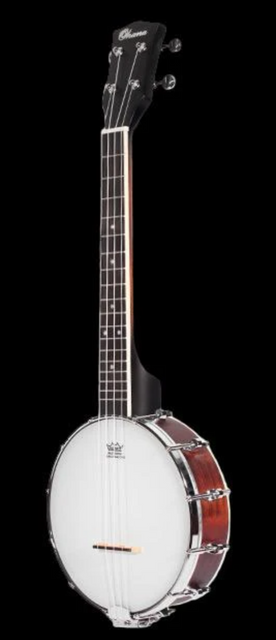A Pedacito of Ukulele Culture
- Emeline Lee

- Jul 26, 2020
- 4 min read
Updated: Jan 7, 2022
Aloha! I’m Emi Lee, and I play the ukulele with my sister, Lise. Together, we perform as “The Lee Sisters” at Hawaiian festivals and musical events all over California, Hawaii, YouTube, and Zoom. We’d like to share what it’s like living in our ukulele world.
The ukulele (pronounced “ooh-kooh-leh-leh”) is a wonderful little instrument that has shown increasing popularity across the globe. With origins from Portugal, this mighty little instrument has been used to play various musical genres—anywhere from traditional Hawaiian to classical jazz.
Ukulele Basics
The term “ukulele” directly translates to “jumping flea,” in the Hawaiian language. The term was coined after players attributed their fingers and fast chord changes to fleas jumping along the fretboard. Ukuleles come in several different sizes, with larger sizes often possessing more frets (meaning a wider range of notes).
In order of smallest to largest, we have the soprano (usually given to young children), concert, tenor, and baritone. If you’re feeling adventurous, there are also experimental ukulele hybrid models such as the banjo-lele, guitar-lele, harp-ukulele, uku-bass, and more.

Playing Ukulele for Starters
The ukulele is the perfect instrument for all ages and does not require a musical background. Its size makes it easy for even the youngest kids to pick up and play (some people start at the age of 4!). Unlike the guitar, the standard ukulele has only four strings, making it one of the simplest instruments to create chords. Since ukulele strings are typically made of nylon—as opposed to the guitar’s harsh steel strings—they are softer on the fingertips.
The ukulele is great for those who want to learn an instrument to back their vocals. In many cases, you may only need two to three chords to put a song together. It is incredibly easy to learn the ukulele, as most chords do not require you to use all four fingers! There is no wrong way to play the ukulele.
Ukulele Today
Ukulele playing today has definitely transformed from the days of Don Ho (“Tiny Bubbles”) and Tiny Tim (“Tiptoe Through the Tulips”) in the 1960s. To this day, one of the most well-known songs associated with the ukulele is “Somewhere Over the Rainbow” by Israel Kamakawiwoʻole, which remains a fan favorite by people across the globe.
Through recent years, the ukulele has transformed from a novelty to an actual instrument with an explosion of artists exploring technical fingerstyles. For example, the ukulele has been used to play a wide range of instrumental renditions, ranging from Queen’s “Bohemian Rhapsody,” The Beatles’ “While My Guitar Gently Weeps,” Pachelbel’s “Cannon in D,” Tchaikovsky’s “The Nutcracker” Suite, Andrew Lloyd Weber’s “Phantom of the Opera,” and even iconic Disney Parks attractions on ukulele! (Shameless plug here). The list goes on and on, as there is nothing you cannot play on ukulele.
The ukulele is very popular with teens and young adults, as it is associated with typical bedroom pop songs, like Jason Mraz’s “I’m Yours” or Jeremy Passion’s “Lemonade.” This simple instrument has lately been used to create more complex melodies, utilizing intense strumming and fingerpicking. Examples of artists from this contemporary world include Jake Shimabukuro, Kalei Gamiao, Brittni Paiva, Taimane Gardner, Kris Fuchigami, Aldrine Guerrero, and numerous young talented players predominantly from Hawaii and Asian countries.
The ukulele’s popularity has spread to countries all over the world. There are even international ukulele festivals in Australia, China, Japan, Korea, the Netherlands, Brazil, Spain, and even the Czech Republic to celebrate the beloved instrument. You can probably find a ukulele group almost anywhere you look. I was surprised to find that even my little suburban hometown of Rancho Cucamonga, CA has a ukulele group. They are called the Rancho Cucamonga Ukulele Strummers Ablaze!

Our Personal Experience
What initially began as a casual hobby surprisingly turned into a wonderful adventure. The people in the ukulele community are some of the kindest, funniest, and most supportive people. The players we’ve come to know are incredibly down-to-Earth and are always more than happy to share their ukulele knowledge. In terms of learning the ukulele, there are so many resources online. There is an abundance of YouTube channels dedicated to teaching everything there is to know about the ukulele for free.
As performers, we’ve always felt welcomed and loved wherever we went, even if we were meeting people for the first time. People do not often expect the ukulele to be such a powerful little instrument, so it’s a lot of fun to perform and show off the wide range of music that you can play on the ukulele.
Beware of the Curse
There is, however, only one serious downside to the ukulele. Ever since the very first strum, my entire family has suffered from its irreversible consequences. Many ukulele players suffer from UAS or Ukulele Acquisition Syndrome. It is a term we coined back in our early days of self-diagnosis, as WebMD and MayoClinic had never experienced something quite as unique as our situation. Similar to a questionable collection, this incurable ailment deprives its host of cash in their wallet as well as living space in their house. With all of the different sizes, colors, sounds, and hybrids of ukuleles out there, why stop at one ukulele when you can have twenty?

Want to know more? Are you interested in becoming a contributor for Pedacitos? We'd love to hear your stories! Send me a message and I will get back to you!



















Thanks for sharing this story, Emi! I hope this inspires others to share about their experiences. Culture is not bound by borders, although we can easily associate culture in this way. Pedacitos Blog is intended to give small insights into a variety of cultures and not just those defined through political means.